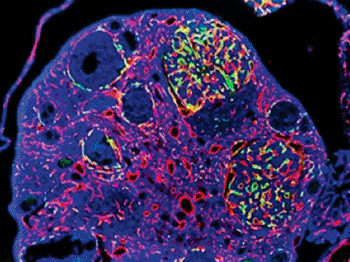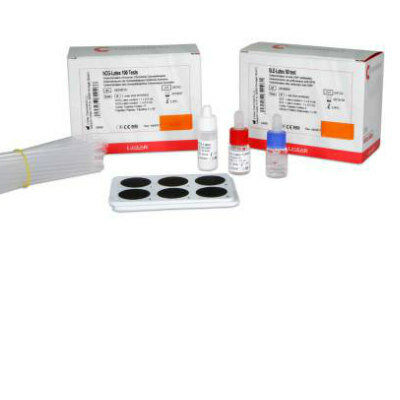Novel Adenoviral Vector Targets Tumor Blood Vessel Endothelial Cells
By LabMedica International staff writers
Posted on 07 Jan 2014
Researchers working with mouse cancer models used a novel gene-therapy approach to demonstrate the potential for directing therapeutic agents specifically to tumor blood vessels while avoid interaction with the liver or other normal tissues.Posted on 07 Jan 2014
Investigators at the Washington University School of Medicine (St. Louis, MO, USA) used a first-generation, inactivated adenoviral (Ad5) vector to transport three kb (kilobases) of the human roundabout4 (ROBO4) enhancer/promoter gene transcriptionally complexed to an enhanced green fluorescent protein (EGFP) reporter.

Image: A case where a primary kidney tumor spread to an ovary: The vectors gathering in the metastatic tumor vessels glow green. The red staining shows the normal blood vessels of the ovary (Photo courtesy of Dr. David T. Curiel and Dr. Jeffrey M. Arbeit, Washington University School of Medicine).
Robo4 is an endothelial cell-specific member of the Roundabout axon guidance receptor family that specifically binds to UNC5B, a vascular Netrin receptor. Robo4 maintains blood vessel integrity by activating UNC5B, which inhibits signaling downstream of vascular endothelial growth factor (VEGF).
In the current study, which was published in the December 23, 2013, online edition of the journal PLOS ONE, the investigators intravenously injected the Ad/ROBO4/green fluorescent vector into immunodeficient mice bearing 786-O renal cell carcinoma subcutaneous (SC) xenografts and kidney orthotopic (KO) tumors.
Results revealed that Ad5ROBO4 directed enhanced green fluorescent protein expression to the tumor neovasculature, whereas a vector whose reporter was controlled by the human Cytomegalovirus (CMV) enhancer/promoter produced sporadic endothelial cell reporter expression in only one or two vessels throughout the tumors.
“We do not want to kill tumor vessels,” said senior author Dr. Jeffrey M. Arbeit, professor of urologic surgery, cell biology, and physiology at the Washington University School of Medicine. “We want to hijack them and turn them into factories for producing molecules that alter the tumor microenvironment so that it no longer nurtures the tumor. This could stop the tumor growth itself or cooperate with standard chemotherapy and radiation to make them more effective. One advantage of this strategy is that it could be applied to nearly all of the most common cancers affecting patients.”
Related Links:
Washington University School of Medicine














